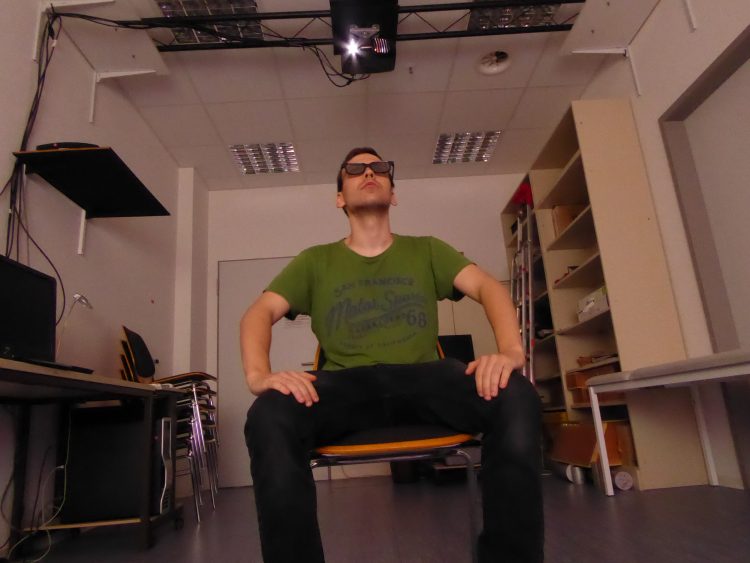Real and artificially generated 3-D films are nearly impossible to distinguish

Test subject watching a 3-D film photo/©: Andreas Baranowski, JGU
For viewers it seems to be very difficult to tell the difference between real and artificially rendered 3-D films. Psychologists at Johannes Gutenberg University Mainz (JGU) have studied the effects of various technologies and found that it plays virtually no role in the viewer’s experience whether a 3-D film was originally produced as such or whether it was later converted from 2-D to 3-D using algorithms as, for example, is the case with new 3-D televisions.
“That is surprising when you consider how much time and money goes into producing real 3-D films,” said Andreas Baranowski of the Institute of Psychology at Mainz University. In the study, test subjects were shown six short film sequences, two each from the categories horror, action, and documentary films. While there were no detectable differences when it came to the two 3-D technologies, there was divergence in the way that the three individual categories were assessed.
The 108 subjects of the study were given 3-D glasses and had to rate the impressions made on them by the film segments. For example, they had to say whether the story in the film drew them in, whether they were impressed by the technological aspects of the film, what type of emotion or excitement they experienced, and whether they felt any sort of queasiness due to the camera movements. They were also asked what they thought of the main characters in the films.
According to the results, 3-D films essentially inspire stronger feelings of being drawn into the story than 2-D films. However, 3-D films also more often cause slight nausea because of what can be described as 'motion sickness'. When it came to the film categories, the researchers in Professor Heiko Hecht’s work group identified stronger effects. Due to the 3-D technology, subjects felt more drawn into the action and horror films, but were less emotionally attached to the main characters in the documentary films than when they watched them in 2-D.
It was of virtually no significance whether the 3-D aspect of the film was real or an algorithmic conversion. This contradicts the common assumption that the stereo disparity of the eyes, i.e. the difference between the two eyes' angles of view of a given object, needs to be accurately reproduced.
“In fact, our visual system seems to be surprisingly tolerant when what it has to do is combine information from the left and right eyes into one stereoscopic image,” explained Baranowski, primary author of the study. However, he also pointed out that during the study the films using the different 3-D technologies were shown one after the other and that any differences might have been more noticeable if they had been viewed in parallel.
Publication:
Andreas M. Baranowski, Kristina Keller, Julia Neumann, Heiko Hecht
Genre-dependent effects of 3D film on presence, motion sickness, and protagonist perception
Displays 44, 53-59, 1 July 2016
DOI: 10.1016/j.displa.2016.06.004
Photo:
http://www.uni-mainz.de/bilder_presse/02_psychologie_3d_filme_01.jpg
Test subject watching a 3-D film
photo/©: Andreas Baranowski, JGU
Contact and further information:
Dipl.-Psych. Andreas Baranowski
General Experimental Psychology
Institute of Psychology
Johannes Gutenberg University Mainz
55099 Mainz, GERMANY
phone +49 6131 39-39278
fax +49 6131 39-39268
e-mail: baranowski@uni-mainz.de
https://www.blogs.uni-mainz.de/fb02-aep/baranowski-andreas/
http://www.sciencedirect.com/science/article/pii/S0141938215300214 – Article in Displays
Media Contact
All latest news from the category: Information Technology
Here you can find a summary of innovations in the fields of information and data processing and up-to-date developments on IT equipment and hardware.
This area covers topics such as IT services, IT architectures, IT management and telecommunications.
Newest articles

A ‘language’ for ML models to predict nanopore properties
A large number of 2D materials like graphene can have nanopores – small holes formed by missing atoms through which foreign substances can pass. The properties of these nanopores dictate many…

Clinically validated, wearable ultrasound patch
… for continuous blood pressure monitoring. A team of researchers at the University of California San Diego has developed a new and improved wearable ultrasound patch for continuous and noninvasive…

A new puzzle piece for string theory research
Dr. Ksenia Fedosova from the Cluster of Excellence Mathematics Münster, along with an international research team, has proven a conjecture in string theory that physicists had proposed regarding certain equations….



